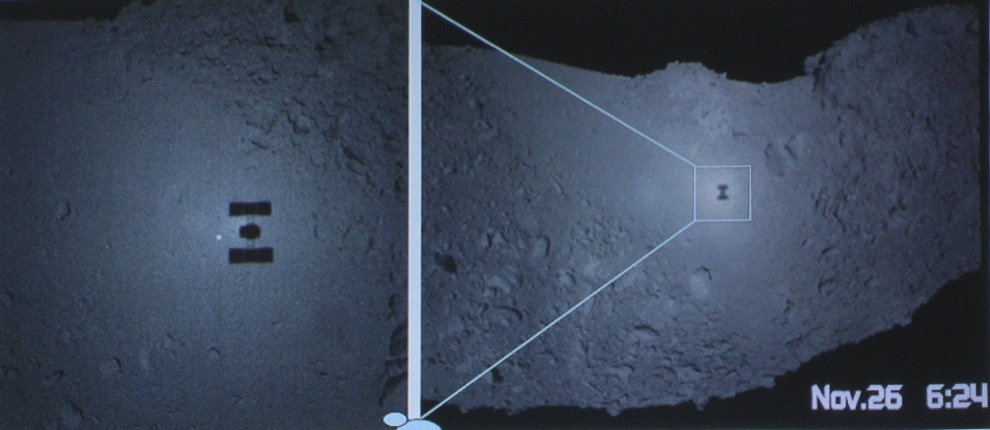ISDC conference report by Dave Fischer
Professor Jun’ichiro Kawaguchi presented the history and results of the Hayabusa program, formally known as MUSES-C.  Professor Kawaguchi is the Program Manager for the MUSES-C program at the Lunar and Planetary Exploration Program Group at JAXA.
Professor Kawaguchi is the Program Manager for the MUSES-C program at the Lunar and Planetary Exploration Program Group at JAXA.
The spacecraft was launched on 9 May 2003. It was primarily an engineering demonstration project, with the following objectives:
- 1. Interplanetary cruise via ion engines as the primary propulsion system
- 2. Autonomous navigation and guidance using optical measurements
- 3. Sample collection from an asteroid surface under micro gravity
- 4. Direct reentry for the sample recovery capsule from interplanetary orbit
- 5. Combination of low thrust and gravity assist for interplanetary missions
The spacecraft was relatively small with dimensions of 1.0m x 1.6m x 1.1m. It weighed a total of 510 kg, of which 380 kg was the spacecraft, instruments and engines, 70 kg of chemical fuel for thrusters and 60 kg of Xenon for the ion propulsion system. The engine was composed of four chambers, each of which developed seven (7) millinewtons of thrust with an isp of 3,000 seconds.
Professor Kawaguchi noted that the mission mostly entailed overcoming obstacles. He presented the following time line illustrating the issues encountered and solved:
- 2004 Fall – Largest solar flare ever of class X25.
- 2005 August – One Reaction wheel lost.
- Arrival at Itokawa.
- 2005 October – Second Reaction Wheel lost.
- 2005 November – Fuel leak after the second touchdown.
- 2005 December – Gas eruption tumbled the space craft. Contact was lost for seven weeks.
- 2005 December – Functioning of the chemical engines was lost. Battery went dead.
- 2006 January – Restoration of attitude control with Xenon cold gas.
- 2006 – Refurbish operation. New attitude control established via Solar Radiation Torque. Charged the battery.
- 2007 January – Closing of the capsule lid succeeded.
- 2007 – First half of the ion engine delta-v burn completed.
- 2009 March – April – Second half of the ion engine delta-v burn completed.
- 2009 November – Ion engine emergency stop due to “End of Life”.
- 2009 November – New ion engine configuration worked
- 2010 June 13 – Final four burns and Re-entry and Recovery of the Capsule.
One of the major accomplishments of the Hayabusa mission was the demonstration of the navigation capabilities of the instruments related to surface detection and ranging. To this end, three markers were deployed as references in order to help zero out horizontal velocity. Using observations by the spacecraft for navigation, positioning improved by 1000%. Horizontal velocity was controlled to within one (1) centimeter per second (cm/s) and position was determined within 10 meters.
The goal was to land on the central (relatively) smooth portion of the asteroid. Eventually, Hayabusa touched down within 500 meters of the original target selected at the beginning of the mission.
One of the major achievements using the navigation system was the placement of the markers, followed by the return to one of them a week later. This was shown by the photographs taken of Itokawa and the navigation markers by the camera aboard Hayabusa:

White Navigation Marker placed 20 November 2005
Shadow of Hayabusa upon Autonomous Return on 26 November 2005.
Image Credit: JAXA
Professor Kawaguchi then discussed the scientific results from the mission. Initial observations from the return capsule did not show much. Eventually, about 1500 particles from Itokawa were recovered. All were smaller than 100 micrometers. Researchers across Japan took 52 of these particles and applied a range of microanalytical techniques – XRD, XRF, UMT, FIB, TEM, SEM, EPMA and SIMS. This alphabet soup clearly showed that Itokawa was a space-weathered ordinary LL chondrite asteroid. [Note: the results were presented at the Lunar and Planetary Science Conference in The Woodlands, Texas, from 7 – 11 March 2011]
Professor Kawaguchi also commented that a follow on mission – Hayabusa 2 – is in the works for the 2014 timeframe.


















